
Quantitative Aptitude Quiz For IBPS RRB PO Prelims Exam: Are you preparing for the IBPS RRB PO Exam? If so, you’ve come to the right place. The IBPS RRB PO Prelims exam consists of 40 Quantitative Aptitude questions. To cover all the questions from the Quantitative Aptitude topic, we have provided IBPS RRB PO Quantitative Prelims Aptitude Questions and Answers in a quiz format. Aspirants can attempt the RRB PO Prelims Quantitative Aptitude Quiz, which consists of 40 questions, to gauge their potential score in the exam. Therefore, FreshersNow has now come up with important questions on IBPS RRB PO Quantitative Aptitude.
★★ IBPS RRB PO Prelims Mock Tests ★★
★★ IBPS RRB PO Mains Mock Tests ★★
★★ IBPS RRB Office Assistant Mock Tests ★★
★★ IBPS RRB Officer Scale 1 Mock Tests ★★
Quantitative Aptitude Quiz For IBPS RRB PO Prelims Exam
1. Direction : Find the wrong term in the given series.
13 55 15 53 21 49 33 35
a. 21
b. 49
c.35
d. 33
e. 53
Answer: b
Explanation:
There are two series
First series:
Given Series
13 + (1 × 2) = 15
15 + (2 × 3) = 21
21 + (3 × 4) = 33
Second Series
55
55 – (1 × 2) = 53
53 – (2 × 3) = 47
47 – (3 × 4) = 35
Therefore, there should be 47 in place of 49.
Hence, option (b) is correct.
2. Directions: Find the wrong term in the given series.
8 11 15 50 104 239
a. 50
b. 15
c. 104
d. 239
e. None of these
Answer: a
Explanation:
Series Pattern Given Series
8 8
8 + 1^3 + 2 = 11 11
11 + 2^3 – 4 = 15 15
15 + 3^3 + 6 = 48 50
48 + 4^3 – 8 = 104 104
104 + 5^3 + 10 = 239 239
Therefore, there should be 48 in place of 50.
Hence, option (a) is correct.
3. Directions: Find the wrong term in the given series:
4 6 16 56 242 1232
a. 16
b. 6
c. 56
d. 242
e. 1232
Answer: d
Explanation:
Series Pattern Given Series
4 4
4 × 1 + 2 = 6 6
6 × 2 + 4 = 16 16
16 × 3 + 8 = 56 56
56 × 4 + 16 = 240 242
240 × 5 + 32 = 1232 1232
Hence, option (d) is correct
4. Directions: Find the wrong term in the given series:
2 9 40 207 1236 8659
a. 9
b. 40
c. 207
d. 1236
e. 8659
Answer: c
Explanation:
Series Pattern Given Series
2 2
2 × 3 + 3 = 9 9
9 × 4 + 4 = 40 40
40 × 5 + 5 = 205 207
205 × 6 + 6 = 1236 1236
1236 × 7 + 7 = 8659 8659
Therefore, there should be 205 in place of 207.
Hence, option (c) is correct.
5. What approximate value will come in place of question mark (?).
2/11 of 1310 × 6.93 = 50% of ?
a. 3680
b. 3120
c. 3332
d. 2860
e. 5210
Answer: c
Explanation:
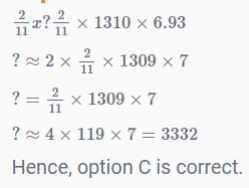
6. What approximate value will come in place of question mark (?).
32% of 460.32 + 50.05% of 583.89 = ?% of 1205.23
a. 18
b. 27
c. 37
d. 47
e. 67
Answer: c
Explanation:
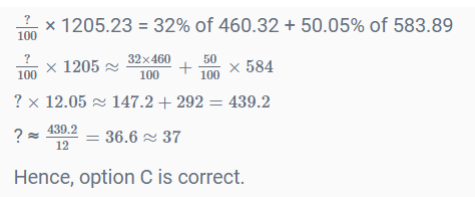
7. What approximate value will come in place of question mark (?)
107.99×67.01–(12.98)^2=?
a. 6850
b. 9640
c. 7070
d. 8450
e. 9500
Answer: c
Explanation:
107.99×67.01–(12.98^)2=?
? ≈ 108 × 67 – (13)^2
?=7236–169=7067≈7070
Hence, option c is correct.
8. A juice seller wants to make a juice cocktail by mixing two flavoured juices. He has a can full of cranberry juice. A certain quantity of cranberry juice is taken out from it and replaced with same quantity of apple juice. The same quantity is again removed from the mixture and replaced with same quantity of apple juice. The mixture now contains 19% apple juice. If the volume of the can is 20 gallons, how many gallons of juice is removed each time?
a. 5 gallons
b. 4 gallons
c. 3 gallons
d. 2 gallons
e. None of these
Answer: d
Explanation:
Initially there was Cranberry juice.
The mixture now contains 19 % apple juice.
The cranberry in the mixture will be 81%.
81% can be written as 811/00= square of 91/0
[liquid is removed twice]
The amount withdrawn is 1/10 of total
→20×1/10=2 gallons
2 gallons have been withdrawn each time.
Hence, option d is correct.
9. Directions: Answer the questions based on the information given below.
A shopkeeper sold two types of chargers namely type B and type C on different days of week. Some of the data in the table are missing you have to find the same and answer the questions accordingly.
Note: On each day number of type C charger sold is more than number of type B charger sold.
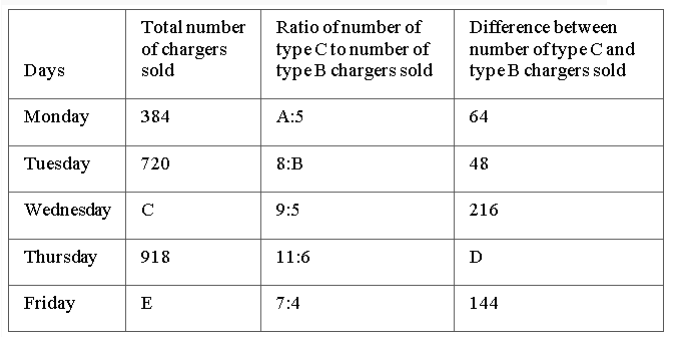
What is the value of E?
a. 548
b. 578
c. 528
d. 538
e. None of these
Answer: c
Explanation:
For A:
(A – 5)/(A + 5) × 384 = 64
6A – 30 = A + 5
5A = 35
So, A = 7
For B:
(8 – B)/(B + 8) × 720 = 48
120 – 15B = B + 8
16B = 128
B = 7
For C:
4/14 × C = 216
C = 756
For D:
D = 5/17 × 918 = 270
For E:
3/11 × E = 144
So, E = 528
E = 528
Hence, option c.
10. Directions: Answer the questions based on the information given below.
A shopkeeper sold two types of chargers namely type B and type C on different days of week. Some of the data in the table are missing you have to find the same and answer the questions accordingly.
Note: On each day number of type C charger sold is more than number of type B charger sold.
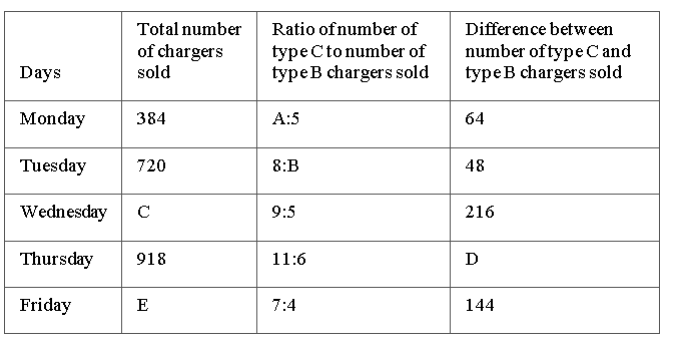
What is the value of A?
a. 6
b. 7
c. 8
d. 9
e. None of these
Answer: b
Explanation:
For A:
(A – 5)/(A + 5) × 384 = 64
6A – 30 = A + 5
5A = 35
So, A = 7
For B:
(8 – B)/(B + 8) × 720 = 48
120 – 15B = B + 8
16B = 128
B = 7
For C:
4/14 × C = 216
C = 756
For D:
D = 5/17 × 918 = 270
For E:
3/11 × E = 144
So, E = 528
A = 7
Hence, option b.
11. Directions: Answer the questions based on the information given below.
A shopkeeper sold two types of chargers namely type B and type C on different days of week. Some of the data in the table are missing you have to find the same and answer the questions accordingly.
Note: On each day number of type C charger sold is more than number of type B charger sold.
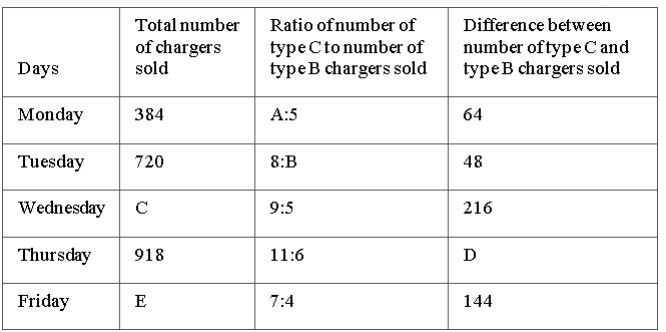
What is the value of C?
a. 756
b. 752
c. 740
d. 748
e. None of these
Answer: a
Explanation:
For A:
(A – 5)/(A + 5) × 384 = 64
6A – 30 = A + 5
5A = 35
So, A = 7
For B:
(8 – B)/(B + 8) × 720 = 48
120 – 15B = B + 8
16B = 128
B = 7
For C:
4/14 × C = 216
C = 756
For D:
D = 5/17 × 918 = 270
For E:
3/11 × E = 144
So, E = 528
C = 756
Hence, option a.
12. Directions: Answer the questions based on the information given below.
A shopkeeper sold two types of chargers namely type B and type C on different days of week. Some of the data in the table are missing you have to find the same and answer the questions accordingly.
Note: On each day number of type C charger sold is more than number of
type B charger sold.
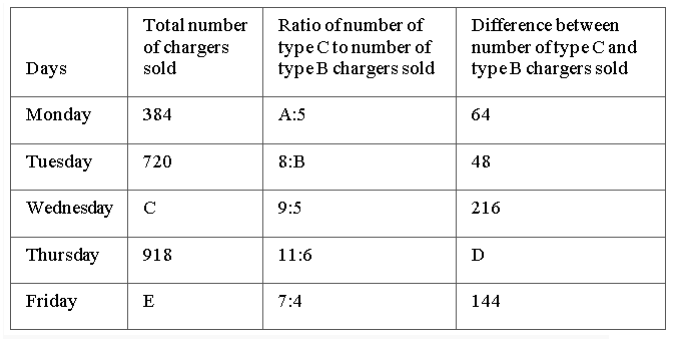
What is the value of B?
a. 5
b. 7
c. 6
d. 3
e. None of these
Answer: b
Explanation:
For A:
(A – 5)/(A + 5) × 384 = 64
6A – 30 = A + 5
5A = 35
So, A = 7
For B:
(8 – B)/(B + 8) × 720 = 48
120 – 15B = B + 8
16B = 128
B = 7
For C:
4/14 × C = 216
C = 756
For D:
D = 5/17 × 918 = 270
For E:
3/11 × E = 144
So, E = 528
B = 7
Hence, option b.
13. A can complete a piece of work in 80 days, B takes 20% more time than A to complete the same work while C takes 25% more time than B to complete the whole work. Find the time taken by all of them together to complete the whole work.
a. 32 days
b. 25 days
c. 35 days
d. 36 days
e. None of these
Answer: a
Explanation:
Time taken by B to complete the whole work = 1.2 × 80 = 96 days
Time taken by C to complete the whole work = 1.25 × 96 = 120 days
Total work (let) = 480 units (LCM of 80, 96 and 120)
Efficiency of A, B and C is 6 units/day, 5 units/day and 4 units/day
respectively
Desired Time = 480/15 = 32 days
Hence, option a.
14. Speed of a boat in still water is 12.5% less than speed of boat in downstream. If the boat can travel a distance of 172.8 km upstream in 4 hours 48 minutes, then find the time taken by the boat to cover a distance of 315 km in still water.
a. 7 hours
b. 7.5 hours
c. 8 hours
d. 8.5 hours
e. None of these
Answer: b
Explanation:
Let speed of boat in downstream = ‘x’ km/h
Speed of boat in still water = 0.875x km/h
Speed of boat in downstream = 0.875x – 0.125x = 0.75x km/h
So, 0.75x = 172.8/4.8 = 36
So, x = 48
Speed of boat in still water = 0.875 × 48 = 42 km/h
Desired time = 315/42 = 7.5 hours
Hence, option b.
15. A and B entered into a business with an initial investment of Rs. 4125 and Rs. 3850, respectively and the ratio of time for which they made their investment is 7:5 respectively. If total profit earned by them is Rs. 8250, then find the profit share of A.
a. Rs. 4950
b. Rs. 5250
c. Rs. 3300
d. Rs. 4995
e. None of these
Answer: a
Explanation:
Ratio of profit share of A to B =(4125×7):(3850×5)=3:2=(4125×7):(3850×5)=3:2
So, profit share of A=3/5×8250=Rs.4950=3/5×8250=Rs.4950
Hence, option a
Direction: Pie-chart 1 shows the different days 6 different workers – A, B, C, D, E and F – take to finish a same piece of work, whereas pie-chart 2 shows the break-up of the piece of work. Use the information given in the charts to answer the questions that follow.
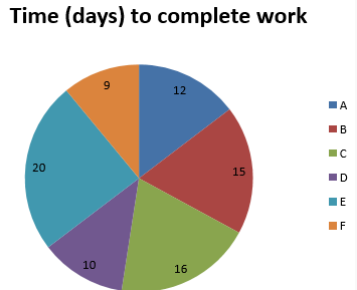
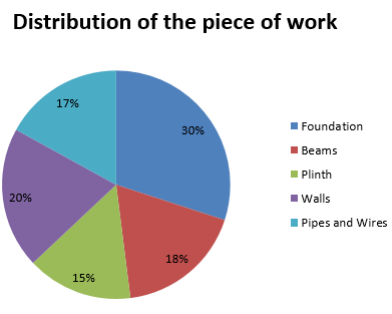
16. If A, B, and F work together to finish Foundation and Pipes & Wires, how many days will it take to finish it?
a. 1.8 days
b. 2.1 days
c. 2.5 days
d. 1.6 days
e. None of the above
Answer: a
Explanation:
Let’s suppose the work is made of 180 units,
A completes the work in 12 days = 15 units/day
B completes the work in 15 days = 12 units/day
F completed the work in 9 days = 20 units/day
Together they put in 47 units a day
Work to be completed= Foundation (30%) + Pipes & Wires (17%) = 47%
No. of day to finish the work = (47% of 180 units) ÷ 47 = 1.8 days
17. D and E decide to complete the Plinth and Beams works which was 1 quarter done and 3-quarters left. How many days will they take to finish the works?
a. 2.4 days
b. 1.65 days
c. 1.12 days
d. 2.45 days
e. 0.75 days
Answer: b
Explanation:
Let suppose the work is made up of 100 units
Contribution of D in 1 day = 100/10 = 10 units
Contribution of E in 1 day = 100/20 = 5 units
Combined contribution = 10 + 5 = 15 units
Work left for Plinth and Beams = 75% of (15% + 18%)
No. of days required to finish the work left = (3/4) * (15% + 18%) of
100÷÷15
= 0.75 * (33/100) * (100/15)
= 1.65 days
18. One day B and C have a competition. B will complete Beams while C will complete Pipes & Wires from scratch. Who is the winner?
a. B is winner
b. C is winner
c. Both finish work at the same time
d. Data inadequate
e. None of the above
Answer: a
Explanation:
Let’s suppose the work is made up of 120 units
B’s contribution in 1 day = 120/15 = 8 units
C’s contribution in 1 day = 120/16 = 7.5 units
B’s work on Beams is 18% of total work
Time taken by B to complete the work = (18% of 120)/8 = 2.7 days
C’s work on Pipes & Wires is 17% of total work
Time taken by C to complete the work = (17% of 120)/7.5 = 2.72 days
Hence, B is the winner.
19. C and E start working on the complete project alone. After working for 8 days, they stopped working and quit. So D was roped in to complete the remaining work. How many days will D take to finish?
a. 2.5 days
b. 1.5 days
c. 3 days
d. 1 day
e. None of the above
Answer: d
Explanation:
Work completed by C and E in 1 day together = (1/16) + (1/20) = 0.1125
Work completed by C and E together in 8 days = 0.9 = 90%
Total time taken by D to complete the whole work = 10 days
Which means D completes 10% of work in 1 day.
Therefore, D will take 1 day to finish the work.
20. A, B, C, D, E and F all decided to work for 1 day in the same order i.e. day 1 – A works alone, day 2 – B works alone… day 6 – F works alone, day 7 – A works alone and so on. Who will finish the work finally?
a. D
b. F
c. B
d. E
e. None of the above
Answer: e
Explanation:
Let’s suppose total work is made up of 360 units
Then contribution of each worker in a dayA = 360 units/12 day = 30 units/day
B = 360 units/15 day = 24 units/day
C = 360 units/16 day = 22.5 units/day
D = 360 units/10 day = 36 units/day
E = 360 units/20 day = 18 units/day
F = 360 units/09 day = 40 units/day
Work completed in 1st cycle = (30 + 24 + 22.5 + 36 + 18 + 40) = 170.5
units
Work completed in 2nd cycle = 170.5 * 2 = 341 units
Since A completes 30 units in 1 day, A will complete the job finally.
We hope the given information about IBPS PO Prelims Quantitative Aptitude Quiz is helpful for all the applied aspirants. So, keep checking our website FreshersNow.Com for more latest updates.



